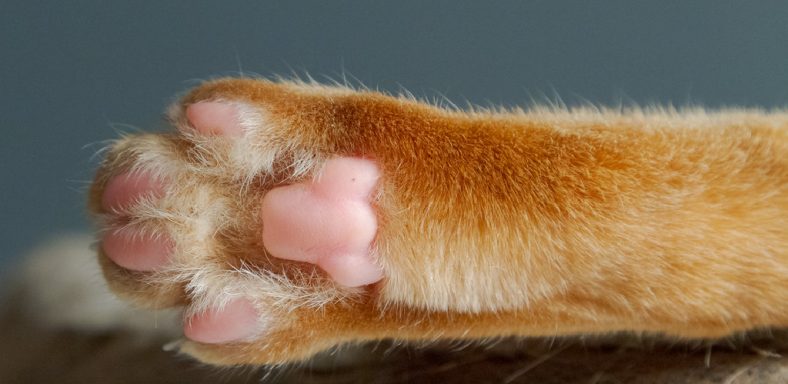As a devoted cat parent, I’m all too familiar with the worries that come up when our beloved feline family members show any sign of unease. Over the years, I’ve grown close to my cats, Bling and DiDi, and watched them closely, so I know how important it is to take care of their paws. Allow me to share what I have learned!
As a caring pet owner, you always want to give your furry friend the best. However, it can be worrying if you catch a glimpse of your cat’s paw pads peeling.
We’ve crafted this guide to provide you with all the details on the common symptoms, causes, diagnosis, treatment, natural remedies, and prevention of peeling paw pads in cats.
So by the time you reach the conclusion, you’ll have a much better understanding of how to care for and keep your pet’s paws in tip-top shape!
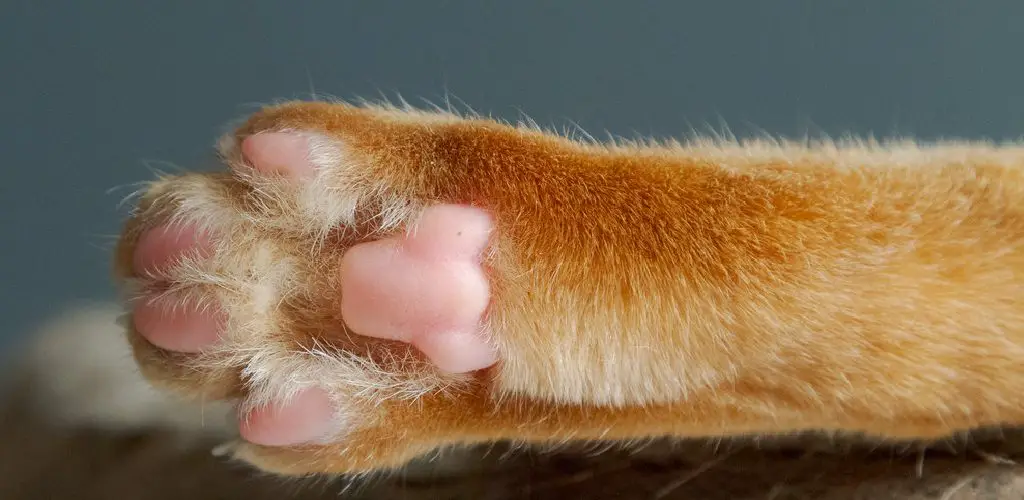
Contents
Symptoms of Peeling Paw Pads in Cats
Cats are known for their meticulous grooming routine and often spend several hours a day meticulously cleaning themselves. While this helps them stay tidy and comfy, it can have unfortunate consequences if they go overboard.
If a cat excessively licks their paw pads, the skin can become inflamed and irritated, eventually leading to an uncomfortable condition called feline acral lick dermatitis (FAD).
Symptoms of FAD include redness, peeling, and bald spots on the affected areas. Let’s make sure our furry friends don’t overdo it so they can remain healthy and comfortable!
If you detect any of these telltale signs in your beloved feline, have a closer look at their paws as soon as possible: Redness and swelling may point to an health issue, and it’s crucial to bring them for medical attention if there is bleeding, scabbing, or limping.
When I saw my cat Bling becoming less active than usual and limping around with inflamed paws, I knew it was time to get help. Luckily, after consulting a vet, the proper treatment was prescribed, which enabled him to heal quickly and be his old energetic self again!
Causes of Peeling Paw Pads in Cats
Cats may experience their paw pads peeling due to a variety of reasons. From allergies, infections, and exposure to the elements, to nutritional deficiencies, stressful conditions or even hormonal imbalances that lead to trauma – your feline friend may be feeling irritated!
If your cat’s paw pads are acting up and you’re not sure why, don’t hesitate to take them to the vet. They’ll be able to professionally assess what’s causing the trouble and suggest the best remedy. So don’t wait! Get your furry pal the help they need today.
My other beloved feline, DiDi, has always been particularly sensitive to weather changes. During the wintertime, his paw pads often experienced dry cracking due to the cold air – yikes!
To protect him from this discomfort, I began using some coconut oil to keep his paws moisturized and safe. Caring for my furry friend has never been so easy!
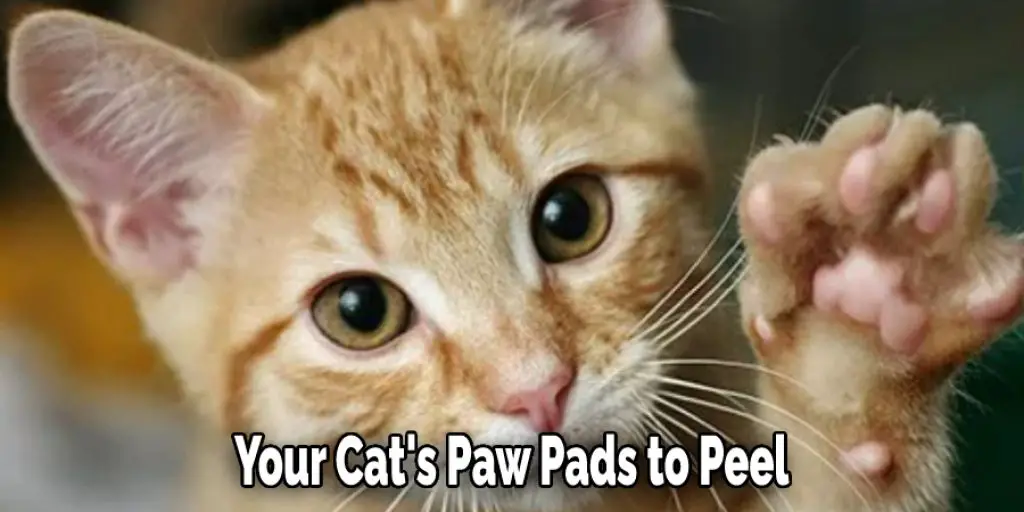
Treatment of Peeling Paw Pads in Cats
Taking care of your beloved kitty’s paw pads is an important part of their health and could require special attention. In some cases, conventional treatments such as antibiotics, anti-inflammatories, creams, and dietary changes may help ease irritation or discomfort.
But for severe ailments, surgery may be essential to repair any damage.
Read Also: 5 Best Moisturizers for Your Cat’s Paws
My cat, Bling, suffered from a serious infection that needed antibiotics and the use of a specialized cream recommended by the vet. Thankfully, with the appropriate treatment, he was able to make a full recovery – his paws looking healthy again!
We suggest that you keep an eye on your cat’s paws for signs of trouble and make sure to get them the help they need if something does come up.
Remedies for Cats Paw Pad Peeling Off
If you’ve spotted your fur baby’s paw pads peeling, it’s time to take action to successfully treat the issue and avoid any further harm.
Peeling paw pads can be caused by different elements, such as allergic reactions, injury, or simply dry skin. Regardless of the root cause, you must keep a keen eye on your feline’s feet and make sure they’re comfortable.
Step 1: Determine the Cause
Discovering why your cat has peeling paw pads is the initial step to treating them. Allergies, injuries, and infections often cause the issue. If your pet spends a lot of time outdoors, an allergy to things like pollen or grass may be the culprit.
If this is the case, you should try keeping them inside for a few days to see if their condition improves.
Injuries can easily occur when cats step on sharp objects or become entangled in something.
It’s important to take them to the vet if you think they have any type of injury.
Finally, infections are another possibility and can be identified by redness, swelling, or pus coming from the paws. Make sure to bring your cat to the vet right away if these signs are present.
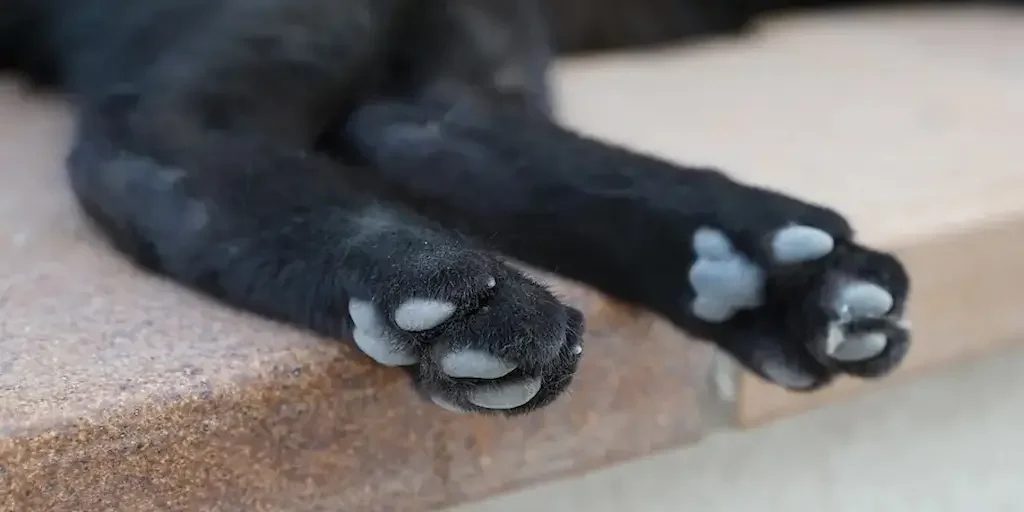
Step 2: Keep the area clean
It’s important to keep your kitty’s paw pads clean if they’re peeling. Doing so will help deter infection and make the healing process quick and effortless.
To start, lather the area with a gentle soap and warm water, then rinse it all off. Disinfecting wipes also work for cleaning. Afterwards, make sure to dry the area completely before you apply ointment or cream.
Step 3: Apply a Moisturizer
Once you’ve gotten the area nice and clean, it’s essential to provide extra care to the skin.
To help soothe and protect your cat’s sensitivity, it’s important to use a product specifically formulated for their delicate skin.
A lotion, cream, or ointment should do the trick but you’ll want to be sure to apply it multiple times a day until the peeling subsides.
If your furry friend is okay with it, diaper rash cream free of zinc oxide can also be an excellent alternative – making it easier to give them that extra TLC they need!
Step 4: Treat the Allergy
If you believe your cat’s paw pads are shedding due to an allergy, it is essential to take action.
To start with, try keeping them indoors if your furry friend has allergies to things they may come into contact with like grass or pollen.
Additionally, bathing them post-outdoor playtime can aid in removing any potential allergens from their coat. Ultimately, these simple steps can help keep your companion more comfortable!
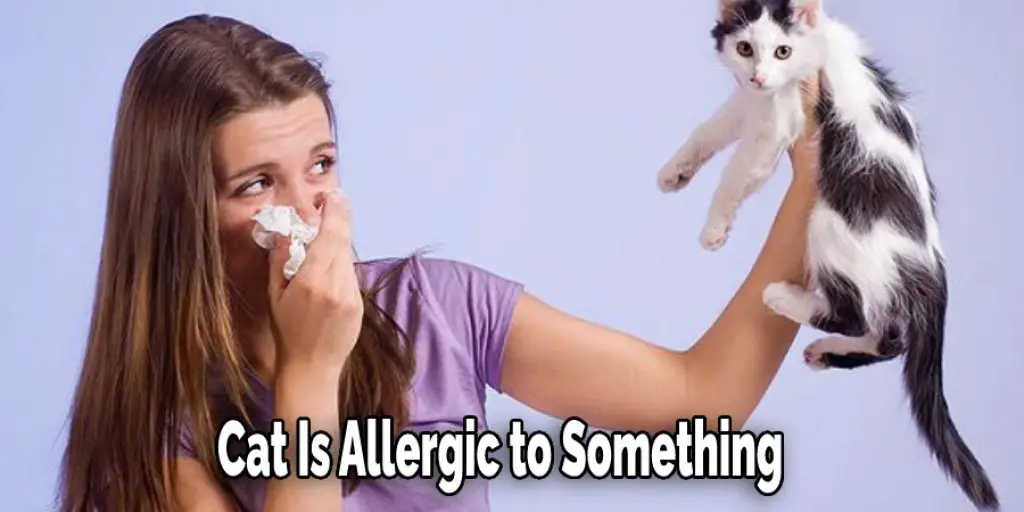
If your kitty is having an allergic reaction to something in their diet, it’s important to switch over to a hypoallergenic food.
To ensure your furry friend finds the perfect fit for them, work alongside your vet and make this transition as smooth as possible!
Step 5: Keep an Eye on the Area
Once you’ve taken care of your kitty’s paw pads, it’s super important to keep an eye on the area.
Look out for any signs that the condition is getting worse or your cat seems more tired than usual—and if so, don’t hesitate to bring them to the vet right away.
With the correct treatment, peeling paw pads will usually heal quickly. But if you’ve got any doubts about your fur baby’s wellbeing, always get them a checkup at the vet!
Natural Treatments for Peeling Paw Pads in Cats
If you’re looking for cat-safe products, we’ve got you covered! Here are some of the most popular options available—all guaranteed to soothe kitty and provide relief from potential discomfort.
Aloe Vera Gel:
Pick up some Aloe Vera Gel from your local health food store and enjoy its many healing benefits! Smear a small amount of it over the cat paw a few times each day for effective relief. Trust us, it’s worth it—your cat will be good as new in no time!
Coconut Oil:
Treat your kitty’s paws with the naturally healing and nourishing power of coconut oil!
Not only is it non-toxic, but it’s a great way to lock in much-needed moisture and keep those sensitive paws safe. All you need to do is apply a small amount directly onto their pads for an instant boost of health and care!
With my fur babies, DiDi and Bling, I’ve been using coconut oil on their paw pads to help keep them hydrated and healthy – and both cats really love it! It’s become a special moment between us that I look forward to every day.
Apple Cider Vinegar:
Give your felines a spa day with this natural paw exfoliation!
Simply combine equal amounts of apple cider vinegar and water into a bowl, and let your pet’s paws soak for 10-15 minutes.
Once done, rinse the paws off with clean water and do this once or twice every week to help keep their paws feeling as soft as possible!

Epsom Salt Bath:
Submerge their paws in a warm bath of 1 cup of Epsom salt combined with 1 gallon of water for 10-15 minutes.
This same technique can also be used to soothe skin issues like hot spots or allergies. Make sure to give your cat’s paws a thorough drying once they’re out of the bath!
Vaseline :
Nurture your kitty’s paw back to its healthy state with a gentle layer of Vaseline! Just bear in mind to steer clear of any other products with artificial scents, colors, or harsh components, as they could cause further discomfort.
Castor Oil:
Revitalize your kitty’s paw pads with the help of castor oil! This thick, moisturizing oil is Just what your furry friend needs to keep their paws supple.
Start by applying a bit of castor oil onto a cotton swab and then massaging it into every paw pad. You can also use your fingers and carefully rub a few drops of the oil into their pads. Doing this for one or two times a day will have their paw pads feeling fresh in no time.
Olive Oil Massage:
To give your cat an olive oil massage, simply warm up a small amount of oil in your hands and then massage it into your cat’s paw pads. Avoid getting the oil into your cat’s eyes or ears.
After the massage, you can either wipe the excess oil off with a towel or let your cat lick it off. If you let your cat licks the oil, monitor them closely to make sure they don’t ingest too much.
Prevention of Peeling Paw Pads in Cats
Taking good care of your kitty’s paws is the best way to ensure their health and happiness. Here are some easy ways you can make sure they stay in tip-top condition!
- Be sure to keep their paws clean and dry.
- Avoid exposing them to hot pavements or extreme weather.
- Purchase a scratching post so their claws are kept trim.
- Feed them a balanced diet, replete with all the vitamins and minerals they need to stay healthy.
- Finally, investing in booties or paw protectors can provide extra protection from severe temperatures and abrasive surfaces.
To guarantee your cat’s paw pads remain healthy and free of peeling, adhere to these simple tips!
Final Thoughts
If you notice anything unusual or wrong about your cat’s paws, don’t wait to take them to the vet! With the right care and attention, you can make sure your cat stays healthy and happy.
Make sure to watch out for any signs that point to paw issues – they could be concerning!
My personal experience with my cats, Bling and DiDi, has taught me the importance of paying attention to their paws and taking care of any issues that arise. With a little bit of love and care, you can keep your furry friend’s paws healthy and happy for years to come!
See also My Cat Licking the Carpet

